
If, like me, you live in a pale colored house with an sunny, south-western aspect, you will always know that cold weather is not far away when, on warm fall days, you see ladybugs swarming all over the exterior, looking for somewhere to hunker down for the winter. That’s not to say that they limit themselves to light colors and a view of the countryside, but it seems certain ladybugs have a preference for such things when it comes to finding somewhere to hibernate. Native ladybugs prefer a natural habitat of plant material and logs, but it seems the Asian lady beetle is particularly drawn to houses as the horizontal stripes of siding resembles the patterns found on the rock faces of their natural environment.
Apart from assuming that the ladybugs crawling over your house’s exterior are most likely non-native, there are ways to tell them apart (although being no expert, I’m not certain by any means!). Asian lady beetles tend to be larger, more elongated, and more orange rather than red in color. However, ladybugs come in several colors and patterns, so that isn’t foolproof. One of the easier ways to identify an Asian lady beetle is by looking at the markings on its thorax. If it shows a distinct M or W pattern, it’s an Asian lady beetle.
I appreciate they are not particularly welcome in our homes, especially as when disturbed they will initiate a defense response of secreting an unpleasant smelling liquid, which unfortunately will also stain what it touches. They are not colored red for nothing—it is to signal to predators that they are unpalatable. In addition, the Asian lady beetle is more aggressive than the native ladybugs, and this bug will actually bite if provoked. Therefore, if you find yourself needing to deal with more than the odd one, the best way to remove them is with a vacuum cleaner. However, by ensuring that your window screens are in good repair, and there are no cracks in window frames or siding that they can get through will go a long way to remedying the problem.
If they tuck themselves into a few exterior nooks and crannies of your house, that’s fine, as regardless of species, all ladybugs voraciously devour aphids. And if you want to help our native ladybugs, providing them with natural hibernation material such as leaves, twigs and logs in out-of-the-way corners of your yard, as well as leaving a few perennials and grasses uncut until the spring is beneficial.
Here’s hoping you just get to appreciate seeing these beneficial insects outdoors, in the knowledge that after six months or so of dormancy, they will awaken one more, starving hungry and ready to wage war on the pests that consume our favorite plants! And lastly, here’s a fun fact for you—the two spotted ladybug, Adalia bipunctata, which is the most common species of ladybug in the state, is officially the state insect of the Commonwealth of Massachusetts.
And finally, Asian lady beetles are not the only insects that attempt to overwinter in our homes.
For more information visit the University of Massachusetts at https://ag.umass.edu/landscape/fact-sheets/house-invaders







